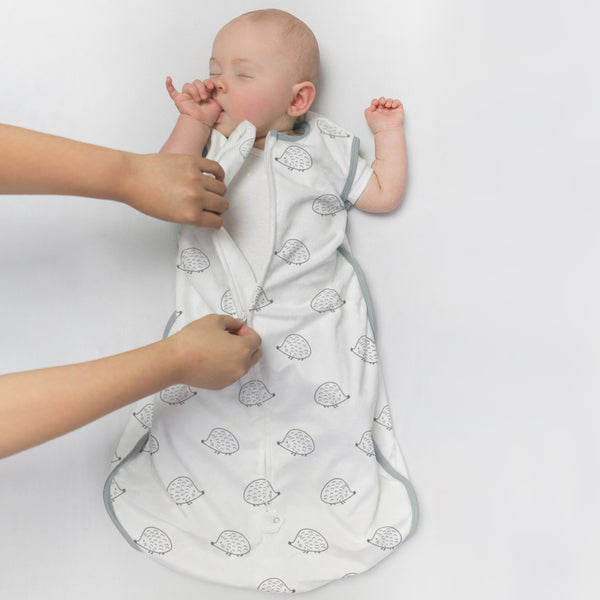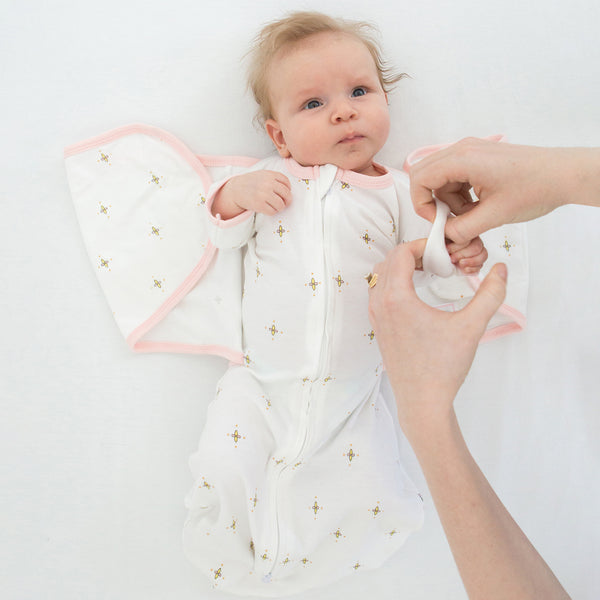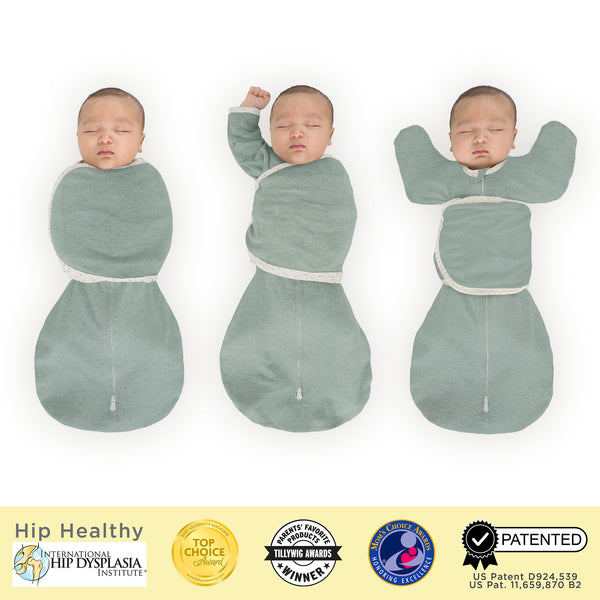
SwaddleDesigns® introduced the Transitional Swaddle Sack in 2018 after many years of development by Lynette Damir, Registered Nurse and mother.
Lynette identified an important transitional time period for babies that occurs around 2-4 months of age. This time period occurs during the developmental process of transitioning from the womb to the world and then transitioning from snug swaddle to loose-fitting wearable blanket or sleeping sack. This is also the time period when baby learns to roll over and should no longer be swaddled with arms fully restrained inside a classic snug swaddle.
Lynette was aware of several issues related to safe sleep during this time period of baby’s development:
- Many babies ages 2-4 months still have a strong Moro or startle reflex and therefore do not sleep well in a loose-fitting sleep sack.
- She observed many parents and caregivers were continuing to swaddle their baby with baby’s arms fully restrained inside a snug swaddle well past the recommended time to stop swaddling due to their baby was not sleeping well in a loose-fitting sleeping sack.
- The American Academy of Pediatrics recommends parents to stop swaddling when their baby starts showing signs of rolling over on to their tummy. While the milestone for baby rolling over usually occurs around 4 months, some babies are able to roll over onto their tummy much sooner.
- Many parents struggle with the recommendation to stop swaddling during this transition time, because their baby doesn’t sleep well without the support of a snug swaddle. If baby does not sleep well, then parents are more likely to try unsafe sleep practices which increases the risk of SIDS and suffocation.
With the knowledge of the issues noted above, and her desire to help new parents, Lynette used her healthcare background and her design education to develop the Transitional Swaddle Sack to bridge the gap between a snug swaddle and a loose-fitting wearable blanket.
The Transitional Swaddle Sack is the missing link in the safe sleep care pathway. The Transitional Swaddle Sack bridges the gap between swaddling with arms fully restrained and a sleeping sack with no arm support.
Little Sleeves with a Big Purpose
The Transitional Swaddle Sack features uniquely shaped half-length sleeves with fold over mitten cuffs. When the cuffs are closed, the little sleeves provide partial suppression of the Moro (startle) reflex, and if baby were to roll over onto their tummy the little sleeves allow enough mobility so baby can lift their head and torso to reposition their head to have access to air. While baby may startle slightly and arouse slightly when wearing the Transitional Swaddle Sack, this is considered a good thing, because baby learns to fall back to sleep (an important skill), because the startle reflex has been softened and the sleeves provide a feeling of reassurance and safety.
The Transitional Swaddle Sack is a very important innovation in safe sleep and has earned utility and design patents. Additional features of the design include:
- The unique half-length sleeve design also allows baby to sleep with arms up which many babies prefer. The sleeves have fold over mitten cuffs that may be worn closed if parents are concerned about facial scratches, or the cuffs may be opened to allow baby to self-soothe by sucking directly on their hand. (We recommend closing the cuffs prior to placing the baby in the sack. Baby’s arms will be in a flexed, natural position, and then if desired, the parents may open one cuff for self-soothing – see image below).
- The Transitional Swaddle Sack design is snug around the tummy which helps baby feel supported and secure.
- The sack portion features a hip healthy design recognized by the International Hip Dysplasia Institute and it supports the baby’s legs in a natural, flexed position. The fabric is stretchy so baby can extend their legs, yet they can feel their surroundings, so they feel secure and sleep better.
- An innovative and helpful 2-way zipper makes it easy to place baby into the sack and easily zip up to secure baby in the sack. The second zipper pull at the foot of the sack may be used to unzip from the foot for easy diaper changes without fully undressing baby. Lynette also included a zipper guard which is a soft piece of fabric the length of the zipper and at the neckline to protect baby’s delicate skin.
- The Transitional Swaddle Sack is made from high quality, durable, soft and stretchy, breathable 100% cotton knit to reduce risk of overheating.
“We worked for years to carefully and thoughtfully perfect the design of the Transitional Swaddle Sack, and we are honored it has earned patents in the USA, Japan and beyond. We appreciate the parents and their babies, and the safe sleep medical experts who participated during the development phase. The Transitional Swaddle Sack is an important innovation to help babies sleep safely as they grow and develop,” said Lynette Damir, RN, founder and creative director.
SwaddleDesigns Transitional Swaddle Sack is a revolutionary product to help babies sleep better and help parents make safe sleep decisions.
The Transitional Swaddle Sack is the easiest way to transition baby from snug swaddle to wearable blanket or sleeping sack.
Swaddle Sack is a registered trademark of SwaddleDesigns.
Lynette designs all the products for SwaddleDesigns with babies’ best interest in mind and parents’ style at heart. She creates all the fabric designs including our new Earthtones Collection and beautiful hand painted watercolor prints.
The American Academy of Pediatrics recommends baby be placed fully on their back on a firm surface in their own space such as a crib or bassinette for every sleep including naps.





